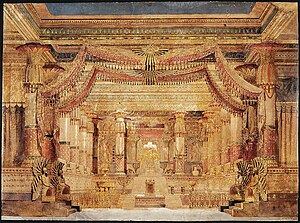
Johann Baptist Wenzel Kautsky (or Jan Václav Kautský; 14 September 1827, Prague – 4 September 1896, Sankt Gilgen) was a Czech scenic designer, landscape painter and co-owner of "Brioschi, Burghart und Kautsky", a stage decorating company in Vienna.

Johann Baptist Wenzel Kautsky (or Jan Václav Kautský; 14 September 1827, Prague – 4 September 1896, Sankt Gilgen) was a Czech scenic designer, landscape painter and co-owner of "Brioschi, Burghart und Kautsky", a stage decorating company in Vienna.
He studied at the Academy of Fine Arts, Prague, from 1844 to 1850 with Christian Ruben (figurative painting) and Max Haushofer (landscape painting). In 1850, he went to Düsseldorf to continue his studies with Johann Wilhelm Schirmer.[1]
The following year, he began work in Prague as a theater decorator. In 1854, he married the actress and writer Minna Jaich, daughter of the scenic designer Anton Jaich. They had a daughter and three sons, one of whom was the Marxist theoretician Karl Kautsky.
In 1863, he was appointed a decorative artist for the Vienna State Opera.[1] The following year, he became a partner in the studios of Carlo Brioschi. Two years later the Viennese Court Painter, Hermann Burghart, was added to the partnership, creating the firm of "Brioschi, Burghart und Kautsky, k.u.k. Hoftheatermaler in Wien", which employed dozens of carpenters, blacksmiths, mechanics and clerks in addition to their painters; among whom were Georg Janny, Leopold Rothaug, Ferdinand Brunner and Alfons Mucha. The studio received many orders from abroad as well as locally. Among their regular customers was the Metropolitan Opera in New York.

Brioschi and Kautsky slowly gave up active participation in the firm, which was led by Burghart until his retirement in 1892.
That same year, Kautsky bought out his partners and handed the company over to his sons, Hans and Fritz, who joined with the Italian-born painter, Franz Angelo Rottonara, and operated under the name "Kautskys Söhne und Rottonara". They remained in business for several more decades.